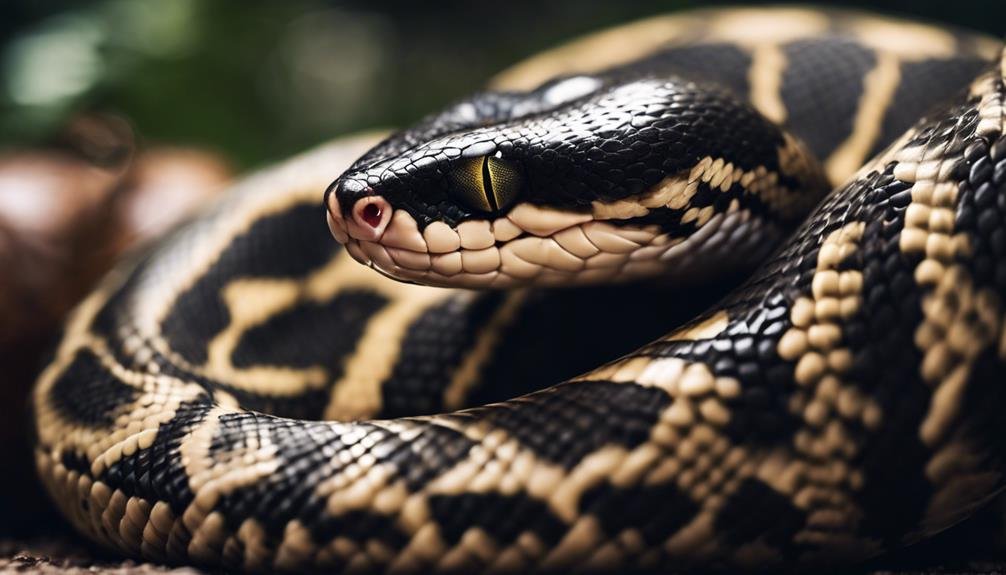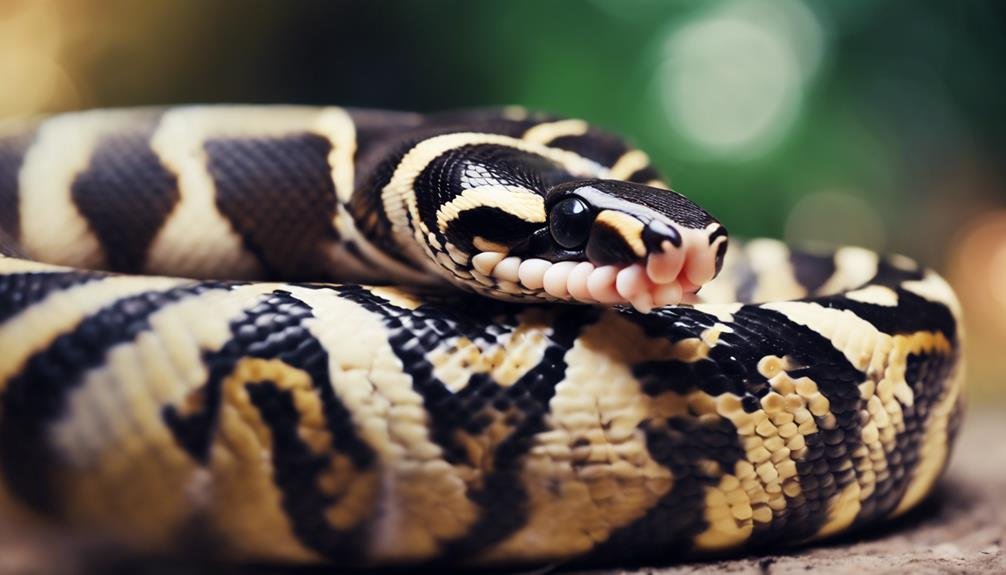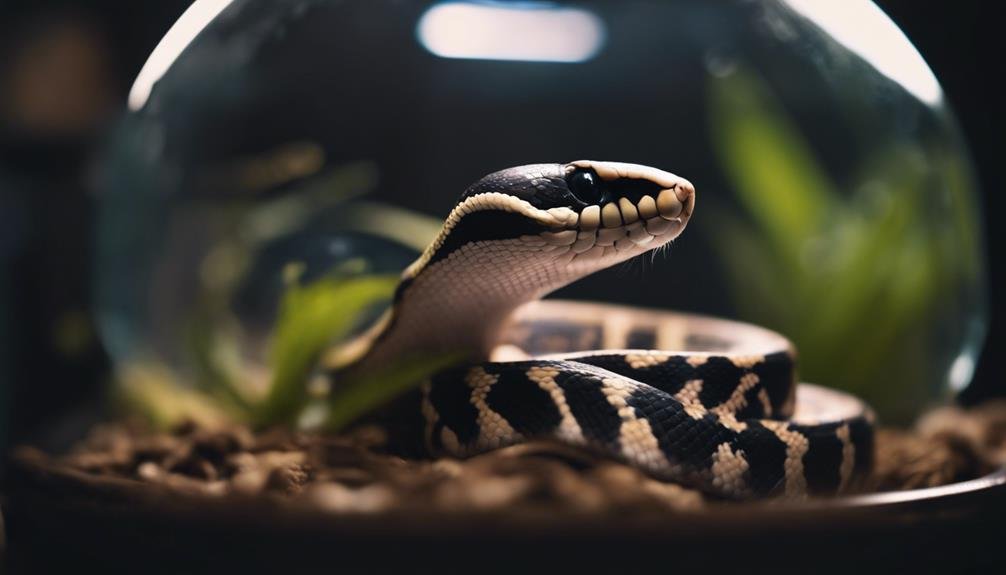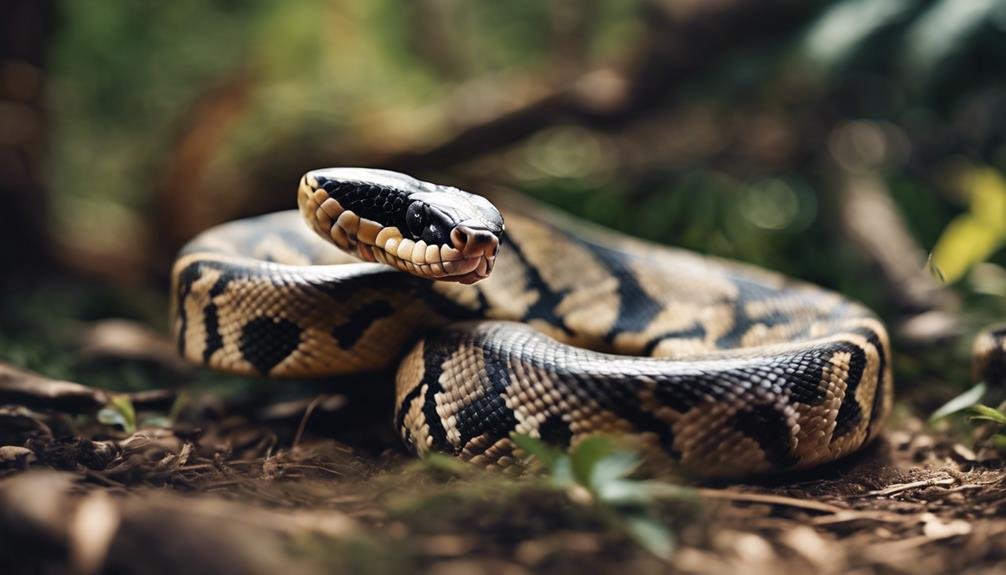You might wonder how ball pythons, seemingly docile creatures, are adept at hunting. Yes, they’re constrictors, using their powerful bodies to ensnare prey in a method that’s both fascinating and efficient. Their ability to detect warmth allows them to launch surprise attacks, primarily at night. What’s intriguing is their preference for suffocation over physical harm, a strategy that guarantees their survival in the wild. As you explore further, you’ll uncover the subtleties of their hunting techniques and how these behaviors translate to their care in captivity. This journey into their world offers insights into their natural instincts and necessities.
Key Takeaways
- Ball pythons utilize the constriction method to suffocate their prey by coiling tightly around them.
- They aim for efficient suffocation without crushing the bones of the prey, ensuring a precise killing technique.
- This species relies on muscular coiling to restrict the prey’s breathing and blood flow, showcasing their strength and efficiency in hunting.
- Their hunting strategy involves ambushing prey, using heat-sensitive organs to strike with precision when the moment is right.
- Ball pythons are adept constrictors, employing both physical strength and specialized adaptations for successful predation.
Understanding Constriction
Constriction, a method ball pythons employ to subdue their prey, involves coiling their bodies to cut off blood flow and prevent breathing. This tactic isn’t about showcasing brute strength or crushing bones but centers on a more strategic approach to immobilize their target. By tightening their grip with each attempt of the prey to breathe, ball pythons guarantee that their prey suffocates efficiently.
You might wonder how this method is humane or efficient. Well, constriction allows ball pythons to capture and consume their prey without expending excessive energy or risking injury. It’s a precise, calculated method that showcases the python’s understanding of its physical capabilities and its prey’s vulnerabilities.
Moreover, this technique highlights the adaptability and survival skills of ball pythons in their natural habitats. They’ve perfected constriction to such a degree that it’s become their go-to strategy for feeding. It’s fascinating to see how nature has equipped these creatures with such an effective mechanism for survival.
In essence, constriction is more than just a hunting method; it’s a proof of the ball python’s evolutionary success in the wild. Through this technique, they’ve secured their place as efficient predators within their ecosystem.
Ball Python Hunting Techniques
As you explore the world of ball pythons, it’s fascinating to see how they utilize their hunting techniques.
They employ an ambush predation strategy, waiting patiently before striking their prey with precision.
Understanding their constriction method and prey detection tactics provides insight into their effectiveness as predators.
Ambush Predation Strategy
Ball pythons utilize an ambush predation strategy, relying on their heat-sensitive organs to detect and stealthily capture prey. They’re not the type to chase down their meals. Instead, they wait patiently, blending into their surroundings until the perfect opportunity arises.
With specialized pits around their jaws, they can sense the warmth of passing warm-blooded animals, making nighttime or hiding in the underbrush ideal for their hunting method. They assess potential prey based on size, scent, color, movement, and importantly, temperature variations. This approach guarantees they strike accurately, surprising their target.
Constriction Method Explained
Once a ball python has its prey within reach, it quickly seizes it with its teeth before wrapping its body around the victim to initiate constriction. This method isn’t about crushing bones but rather cutting off the prey’s breathing. Through this precise technique, the python guarantees that the prey’s heartbeat stops, signaling it’s time to release the grip and start the meal.
Constriction is a highly efficient hunting strategy that allows ball pythons to take on various prey, from mammals and birds to other reptiles. It’s this ability to adapt and utilize constriction so effectively that underscores their success as predators. This method isn’t just about power; it’s about precision, showcasing the ball python’s prowess in subduing meals efficiently.
Prey Detection Tactics
To effectively hunt, ball pythons employ a combination of keen smell and heat-sensitive pits to zero in on their prey. These ambush predators excel in the art of stealth, using their heat-sensing organs not just to detect, but also to assess the size, scent, color, movement, and temperature of potential meals.
By waiting in silence, they position themselves for the perfect moment to strike, ensuring their attack is sudden and unexpected. The pits around their jaws are essential, aiding them in tracking and targeting warm-blooded prey with precision.
This method allows them to identify and latch onto unsuspecting creatures, showcasing their prowess as skilled hunters in their natural habitat.
Physical Adaptations for Hunting
You might wonder how ball pythons manage to be such effective hunters.
Their muscular coiling technique allows them to suffocate prey by tightly wrapping around it, while heat sensory pits enable them to detect warm-blooded animals even in complete darkness.
These adaptations make them formidable predators in their natural habitat.
Muscular Coiling Technique
Utilizing a muscular coiling technique, ball pythons constrict their prey to subdue and immobilize them effectively. This method isn’t about brute force; it’s about precision and efficiency.
By wrapping their bodies around their prey, they squeeze just enough to restrict breathing and blood flow. It’s a non-venomous strategy, showing that nature has ways of guaranteeing lethality without toxins.
This physical adaptation is key to their survival, allowing them to handle prey of various sizes. You’ll find that their ability to control and overpower their targets isn’t just about strength but also about strategy.
They’ve perfected this technique to make sure they can capture and consume their food effectively, illustrating the power and adaptability of the muscular coiling technique in the wild.
Heat Sensory Pits
Ball pythons possess specialized heat-sensing pits around their jaws, enabling them to detect the body heat of warm-blooded prey with remarkable accuracy. These pits are a key necessity that makes you an effective hunter, even in the dark.
Here’s how these heat-sensing pits enhance their hunting abilities:
- Detecting Prey: They can identify the size, scent, color, movement, and temperature of potential prey.
- Ambush Tactics: These sensory pits allow for efficient ambushing, as they don’t have to rely solely on vision.
- Enhanced Efficiency: By lurking and swooping in on unsuspecting prey, these pits improve their hunting success.
- Adaptation: The presence of these pits is essential for thriving as ambush predators in their natural habitats.
This adaptation guarantees you’re always one step ahead of your prey, blending seamlessly into your environment until the perfect moment to strike.
The Prey of Ball Pythons


Understanding the diverse diet of ball pythons is essential for their care, as they prey on small mammals and birds, adapting their feeding habits based on availability and size. Their preference for small mammals like rats, gerbils, and jerboas in the wild is a testament to their opportunistic nature. You’ll find that in captivity, the diet shifts slightly, with a heavy reliance on readily available rodents such as mice and rats to meet their nutritional needs.
Here’s a closer look at what ball pythons eat:
| Prey Type | Examples |
|---|---|
| Small Mammals | Rats, Gerbils |
| Jerboas | |
| Small Birds | Varies |
| In Captivity | Mice, Rats |
| Larger Prey | Rabbits, Small Birds |
This table highlights their versatile diet, ensuring they get the variety needed for their well-being. Their ability to adapt to different prey sizes, targeting larger animals like rabbits and small birds as they grow, showcases the importance of understanding their feeding behavior. Catering to their dietary preferences is critical for their care, ensuring they remain healthy and thrive in captivity.
Detection and Strike Strategy
After exploring what ball pythons eat, let’s examine how they detect and launch their attack on prey. As constrictors, ball pythons possess unique adaptations that enable them to be efficient hunters. Their hunting strategy is a blend of stealth, precision, and power, designed to capture their prey unawares and secure a meal.
Here’s how they do it:
- Keen Sense of Smell: Ball pythons use their exceptional sense of smell to track down prey, even in complete darkness.
- Heat-Sensing Pits: Located around their jaws, these specialized pits allow ball pythons to detect the body heat of warm-blooded animals, guiding them to their next meal.
- Ambush Tactics: They excel at lying in wait, blending into their surroundings until the perfect moment to strike with lightning speed.
- Precision Strike: Once they’ve detected their prey, ball pythons launch a swift attack, grabbing their victim with sharp teeth before coiling around it.
This method of hunting underscores the efficiency of ball pythons as constrictors. They’re not just lying around; they’re actively sensing, stalking, and subduing their prey with remarkable adaptability and precision.
Suffocation Vs. Crushing


Many people mistakenly believe that pythons crush their prey, but they actually suffocate it by tightening their coils. This method, known as constriction, is a highly efficient way for pythons to subdue their meals without causing unnecessary harm. You might find it interesting that during constriction, the python’s goal isn’t to break bones but to stop the airflow to the lungs, leading to suffocation.
Here’s a quick comparison in a table format to clear up any confusion:
| Aspect | Constriction | Crushing |
|---|---|---|
| Goal | Suffocation | Physical harm |
| Method | Tightening coils | Applying force |
| Outcome | Stops breathing | Breaks bones |
| Harm to Prey | Minimal (until suffocation) | Significant physical damage |
| Python’s Approach | Methodical and precise | Not applicable |
Constriction is all about efficiency. The python aligns itself with the prey’s body, applying just enough pressure to restrict breathing. Once the prey’s heartbeat stops, the python knows it’s safe to release its grip and start the feeding process. This highlights how constrictors use their strength and strategy rather than brute force to capture their prey.
How Does a Ball Python’s Climbing Behavior Relate to Its Constricting Hunting Mechanism?
Ball pythons climbing behavior is directly related to their constricting hunting mechanism. In the wild, ball pythons use their climbing skills to ambush prey from above, then constrict them with their powerful muscles. This combination of climbing and constricting allows them to efficiently hunt and capture their food.
Feeding Habits Explained
Ball pythons typically use their constricting ability to subdue prey before consuming it headfirst, guaranteeing a swift and efficient meal. As constrictors, they’ve developed a unique method of hunting that allows them to tackle prey in a manner that’s both important and safe for themselves. This process is fascinating to observe and vital for their survival in the wild.
The strategy they employ isn’t about brute force but rather a calculated method to immobilize their prey. Here’s how they do it:
- Coil and Squeeze: They wrap their bodies around their prey, applying pressure in a controlled manner. This isn’t about crushing bones but stopping the prey’s movement and circulation.
- Suffocation: By restricting breathing, they make sure the prey can’t fight back, leading to a quicker and less risky meal.
- Headfirst Consumption: Starting with the head makes swallowing easier due to the natural tapering of most prey animals.
- Efficient Kill: This method allows for a quick and efficient kill, minimizing the python’s exposure to potential harm.
Understanding these feeding habits gives insight into why ball pythons are such successful predators in their natural habitats. Their role as constrictors is a key aspect of their survival and an interesting study in the efficiency of nature’s designs.
Captive Care and Diet


To guarantee your ball python thrives in captivity, it’s vital to create an environment that closely mirrors their natural habitat, complete with proper heating, lighting, and humidity. You’ll also need to make sure there are enough hiding spots to make your snake feel secure. A balanced diet is important. Feeding them appropriately sized rodents, like mice or rats, covers their nutritional needs since these mammals are what they’d typically hunt in the wild.
Here’s a quick guide to help you manage their care and diet:
| Aspect | Requirement | Purpose |
|---|---|---|
| Enclosure | Heating, Lighting, Humidity | Mimics natural habitat |
| Hiding Spots | Multiple | Provides security |
| Diet | Mice or Rats | Meets nutritional needs |
| Water | Clean and Accessible | Aids in digestion and hydration |
| Health Monitoring | Regular Checks | Ensures thriving in captivity |
Always provide clean water to aid in digestion and to keep them hydrated. Regular monitoring of their weight, shedding, and overall health helps ensure they’re not just surviving, but truly thriving. Considering occasional vitamin and mineral supplementation might prevent nutritional deficiencies, making your captive care routine well-rounded and effective.
Conclusion
In summary, as a ball python owner, you’re caring for a skilled constrictor that uses its body to suffocate prey without harming it. Understanding their need for small mammals or birds, and providing a diet that mimics their natural hunting habits, is essential.
Remember, their unique heat-sensing ability and muscular coiling are key to their hunting strategy. Making sure their habitat closely resembles their natural environment will keep them healthy and satisfied.
Proper care and attention to their feeding habits will guarantee your ball python thrives.


